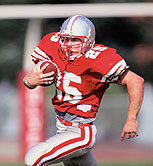- Skip Storing This Everyday Product in the Fridge Door
- Green Tea + B3 Pairing May Boost Brain Health
- Navigating Your Midlife Crisis: Embracing New Possibilities
- City Raccoons Showing Signs of Domestication
- Mapping the Exposome: Science Broadens Focus to Environmental Disease Triggers
- One Week Less on Social Media Linked to Better Mental Health
- Your Brain Changes in Stages as You Age, Study Finds
- Some Suicide Victims Show No Typical Warning Signs, Study Finds
- ByHeart Formula Faces Lawsuits After Babies Sickened With Botulism
- Switch to Vegan Diet Could Cut Your Greenhouse Gas Emissions in Half
College Football Players Have Stiffer Arteries, Study Finds


College freshmen football players show signs of having stiffer blood vessels than their leaner peers who don’t play football, according to new research.
Exactly what that means for players’ later heart health isn’t yet clear.
“The football players in our study already demonstrated increased — not yet abnormal — but significantly increased arterial stiffness,” said the study’s lead author, Dr. Jonathan Kim, a clinical fellow in cardiovascular disease at Emory University in Atlanta.
Stiff, less flexible arteries can lead to higher blood pressure and eventually to heart disease or stroke because blood can’t travel freely through harder blood vessels, according to the U.S. National Heart, Lung, and Blood Institute.
Kim, who presented the findings at the just-concluded American College of Cardiology’s annual meeting in Washington, D.C., said the research doesn’t show football is harmful. “But we do see this observation, so we should focus on high-risk players and check their blood pressure more than the average athlete and keep track of it,” he said.
Previous research has shown that professional football players are more likely to have high blood pressure or elevated normal blood pressure. Kim and his colleagues wanted to see when and where blood pressure changes might begin.
“We looked at players who hadn’t even played college football yet. The arterial stiffness occurred during high school play,” Kim said.
For the study, the researchers recruited 50 incoming freshmen football players and compared them to a group of 50 age- and race-matched freshmen who didn’t play football. The football players were taller and had a significantly higher body mass index (BMI, a ratio of weight to height) than their nonplaying peers.
The average BMI for football players was 29.2 versus 23.7 for the nonplayers. BMI levels up to 24.9 are considered normal weight. From 25 to 29.9 is considered overweight and 30 and over is obese, according to the U.S. Centers for Disease Control and Prevention.
Football players also did more weight training — 5.4 hours a week on average compared to 2.4 hours a week for the nonplayers, the study found.
Although the nonplayers had higher blood pressure levels overall than the football players, a measure of arterial stiffness called pulse wave velocity found the football players had greater blood vessel stiffness.
“Pulse wave velocity was higher in football players. Whether or not this predicts [high blood pressure] in this group, we don’t know. This study found an association, not causality,” said Kim.
There probably are multiple reasons why football players are more likely to have greater blood vessel stiffness, Kim said. “Certainly, football players’ large size has something to do with it. Extreme weight changes may play a role,” he said. Undiagnosed sleep apnea (a sleep disorder linked to high blood pressure), medications they take or “something about the way they train” could also be factors, suggested Kim.
Cardiologist Dr. John Erwin III, who played college football himself, said he’s not sure this study proves that football is an issue in blood vessel health as much as weight is. The nonplayers were significantly leaner than their football-playing counterparts, so Erwin contends that the study really showed an association between a higher body mass and blood vessel stiffness.
“[But] I do think that college football players should have some concern about their future health, especially those who strive (or are pushed) to carry a large amount of mass on their frames,” added Erwin, vice chair of internal medicine at the Scott & White Heart and Vascular Institute in Temple, Texas. “Not only can this lead to eventual cardiovascular complications, but it also takes a huge toll on the joints.”
Parents can help, he said, by providing nutritious meals and objecting to “the kid’s or the coaches’ pressure to push to gain more weight than what their frame can carry in a healthy way.” They should also encourage their kids to stay involved in other physical activities that can be enjoyed lifelong to help maintain health, advised Erwin.
Kim acknowledged more research is warranted. “There’s still a lot we need to learn,” he said.
Research presented at meetings should be considered preliminary until published in a peer-reviewed medical journal.
More information
Learn more about weight and heart health from the U.S. National Heart, Lung, and Blood Institute.
Source: HealthDay
Copyright © 2025 HealthDay. All rights reserved.










